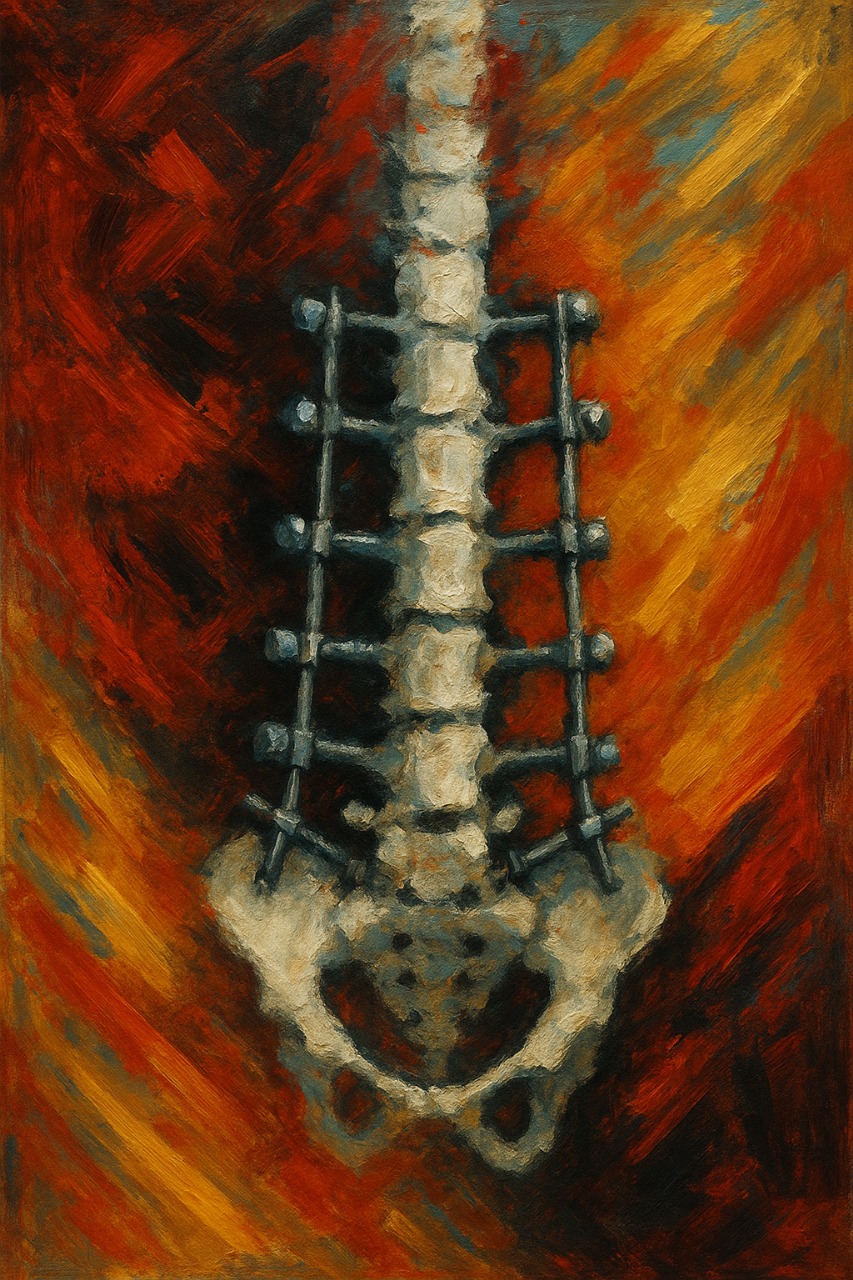The spine doesn’t just support you – it bears your pain and helps you dance again
There was no war, no raging Armageddon. And yet, as the postoperative X-ray glowed on the monitor in the operating room, it bore a striking resemblance to a landscape once ravaged, now reclaimed. Screws gleamed like swords embedded deep into the vertebral columns — a battleground not of bloodshed, but of precision and purpose. The spine, once bent and unstable and in pain, had found its resurrection. Harmony, at last, was restored.
Pramila was a woman in her late fifties with a presence so warm and abundant that one couldn’t help but be reminded of the Laughing Buddha, not in jest but in reverence. She limped into our outpatient clinic, her wide smile shadowed by months of unrelenting pain shooting down both legs. She was dressed in a vibrant green saree, hair pulled back in a ballerina bun, but the picture of grace stopped there. “I’m miserable,” she said to me in Gujarati. “I can barely walk a few steps, and that too with complete dependence on the stick,” she spoke, breathless from the ache. “She used to be a dancer,” her son interjected, while she quickly shushed him with a nudge on his thigh under the table. “Gone are the days,” she lamented, her eyes welling up.
Her spinal MRI revealed the underlying chaos: a compressed lumbar canal, thickened ligamentum flavum pressing down like a stubborn boulder, and listhesis — a slipping of one vertebra over the other — disrupted the spinal alignment. If the spine is a stack of pearls on a string, hers had begun to unravel. Beauty and fragility are always side by side in the world of anatomy.
Since she had tried a year of medication and physiotherapy, I told her the only solution lay in surgery, specifically, a laminectomy to remove the pressure-inducing lamina and ligament, and fusion with rods and screws to restore strength and stability. Pramila and her son took their time to think. I half-expected them to come back with a detailed list of pros and cons, complete with colour coding and lamination. But a couple of days later, she simply walked in, flashed her slow, knowing smile, and declared, “Let’s do it.” In my experience, people are more fearful of undergoing spine surgery than a brain operation – probably because if spine surgery goes wrong, you can’t run away from your problems.
In the operating theatre, we carefully positioned her prone. The drapes were placed, the OT lights dimmed to spotlight intensity, and the battle began — not against disease, but against the pressure crushing her from within. I drilled the lamina along with the facet one after the other over three levels and elevated chunks of bone shaped like perfectly symmetrical butterflies, a fleeting sculpture of calcium and curve, nature’s poetry even in fragments. It was a reminder that beauty resides in even the most hardened of places. And then I momentarily paused to think, “What if butter flies had bones?” “Then their graceful flight would turn into clumsy moans!” retorted an intern who was assisting us. Oftentimes, surgery is a perfect mix of science and silliness.
The spine is a remarkable structure. More than a column of strength, it is the silent stem that holds up the mind’s crown. Where the brain commands, the spine obeys, bearing the weight of movement, memory, and meaning. Unlike brain surgeries that whisper of celestial complexity, spine surgeries have a grounded rawness to them, almost like carpentry, yet deeply delicate. There is elegance even in the act of chiselling.
Beneath the lamina, the thickened ligamentum flavum loomed like a rock — heavy, oppressive, and unmoving. As we unearthed it with each bite, the compressed dura pulsated gently as we finally decompressed it, and with each millimetre of freed space, I imagined her nerves sighing in relief. We inserted pedicle screws across multiple levels, and the rods joined them, forging a new alliance in her spine. When the intraoperative X-ray lit up the screen, we paused. The image was arresting. The screws, aligned like warriors, were embedded in the vertebrae like swords in soil. A battleground won. A spine reclaimed.
Pratima woke up smiling. Her legs no longer bore the same pain. And as she chuckled her deep, vibrant laugh, one that echoed in the halls of recovery, I felt the triumph not of a surgeon, but of nature allowed to realign itself. The spine is not just a pillar of support. It is the silent bearer of weight and pain, of motion and memory. It arches in defiance, bends in surrender, and endures in silence. In realigning Pratima’s spine, we did not just restore anatomy, we renewed grace in posture, laughter in breath, and lightness in every step forward in the hope that someday she would dance again.
Over the next few days, she was walking unaided. When I went to see her on the day she was getting discharged, the walker she was using before surgery was confined to one corner of the room. Her son was drying his washed underwear on it. I looked towards it with raised eyebrows and then towards him. “It’s of no use to her now, we’re just finding other uses for it,” he said.





11 thoughts on “The surgical battlefield”
This article resonated with me. The pain relief immediately post surgery is no less than a miracle.
Doc, your method of mixing light humour with seriousness of complicative surgery makes reading your articles most addictive. Welldone
Dear Mazda,
Thank you for this interesting most colourful description of a jovial Pramila-ben regaining her lost gait, who is now surgucally cleaved of years of painful incarceration.
I would like to ask a question: regarding the duration of relief. Pramila enjoys better mobility and pain free following laminectomy surgery immediately postoperatively. Has the relief persisted into the ensuing years? Or, is it too early to tell?
I ask this because there are studies showing recurrence after an initial period of relief following surgery. Longitudinal studies have shown that after a period of two years the benefit from surgery is no better than that of conservative therapy.
To cite one of many similar studies:
Gugliotta M, da Costa BR, Dabis E, et al Surgical versus conservative treatment for lumbar disc herniation: a prospective cohort studyBMJ Open 2016;6:e012938. doi: 10.1136/bmjopen-2016-012938
I look forward to your response.
Dear Mazda
I love your simple approach to your work. I have been your patient and always remember those comforting words. As for your work you Arde one of the best! Continue to serve humanity with love and care. God bless
Ditto!!! Mothers are the spine of the household bearing every responsibility with grace n endurance!
A mother restored is a family restored!!! Kudos!!
Dr. Mazda,
There are not enough words to express how much we value your venerable human service. Your work has touched our lives and made an indelible positive impact. We ask God to bless you and your efforts, and to sustain your health and well-being to continue this honorable path.
Enjoyed the spinal cord article . There is always a tussle between orthopaedic surgeons specialised in spinal surgery and neurosurgeons about who should tackle these problems . There is no correct answer to the question . However, I am sure this article will motivate those with similar problems as your patient to seek professional help in time !
Dear doctor, protima,sure is a lucky lady to have found u and gone to u for her treatment. May she and her doctor always b in good health and may the walker finds it’s use only by supporting to dry underwear.
Dear Mazda,
You are God’s gift in the form of a neurosurgeon. You save lives. The way you have explained the surgery so vividly, I actually felt like I was there.
Kudos to you. God bless
Thank you so much for this educative write up
Dearest Dr Mazda sir
Once again as usual superbly described piece on Spine Surgery & detailing of all of he nitty gritty of spine ……..
We are also equally enjoying your parting stroke of use of walking stick at the end with typical humorous shot…